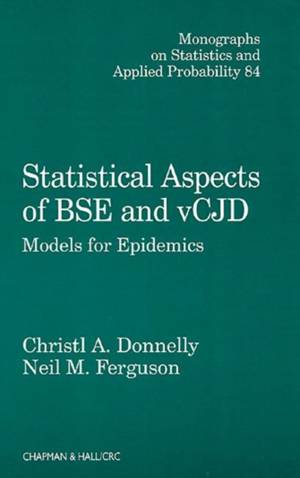
- Afhalen na 1 uur in een winkel met voorraad
- Gratis thuislevering in België vanaf € 30
- Ruim aanbod met 7 miljoen producten
- Afhalen na 1 uur in een winkel met voorraad
- Gratis thuislevering in België vanaf € 30
- Ruim aanbod met 7 miljoen producten
Zoeken
€ 231,45
+ 462 punten
Omschrijving
Bovine Spongiform Encephalopathy (BSE) or "mad cow disease," first diagnosed in late 1986, is transmitted through feed, indirect horizontal transmission, apparently maternally and possibly horizontally, through cattle-to-cattle contact or a contaminated environment. With no ante-mortem test yet developed, the only information available about BSE is from case surveillance and a limited number of experiments. Only through careful and rigorous modeling and analysis can reliable estimates of past infection and predictions of future cases be made. The modeling developed for BSE utilizes a range of techniques from statistics, ecology, and demography that is of interest both as a case study and for providing tools for other modeling projects. Statistical Aspects of BSE and vCJD: Models for Epidemics presents the general methodology required for thorough analysis and modeling of novel long incubation diseases with largely unknown etiology. BSE in British cattle is the primary example system presented, but application to other diseases, particularly the transmissible spongiform encephalopathies (e.g., Scrapie in sheep and nvCJD in humans) are also highlighted. The book concentrates on presenting an exposition of the "state-of-the-art" rather than introductory material on the mathematical/statistical modeling of infectious diseases.
Specificaties
Betrokkenen
- Auteur(s):
- Uitgeverij:
Inhoud
- Aantal bladzijden:
- 256
- Taal:
- Engels
- Reeks:
- Reeksnummer:
- nr. 84
Eigenschappen
- Productcode (EAN):
- 9780849303869
- Verschijningsdatum:
- 21/07/1999
- Uitvoering:
- Hardcover
- Formaat:
- Genaaid
- Afmetingen:
- 163 mm x 243 mm
- Gewicht:
- 521 g

Alleen bij Standaard Boekhandel
+ 462 punten op je klantenkaart van Standaard Boekhandel
Beoordelingen
We publiceren alleen reviews die voldoen aan de voorwaarden voor reviews. Bekijk onze voorwaarden voor reviews.








